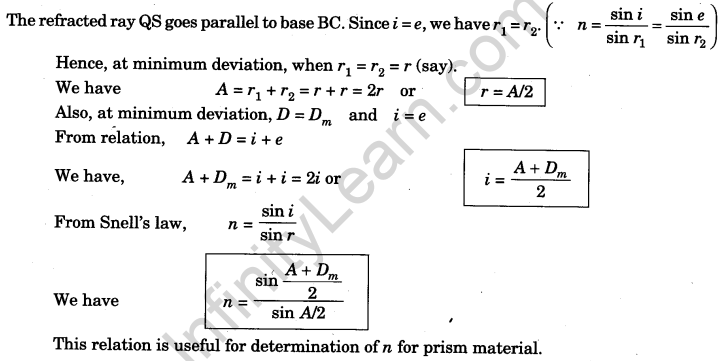Refractive Index of Prism Material, Glass Slab and Transparent Liquid
Refraction
(a) Introduction: When a ray of light travelling in a straight line in a transparent homogeneous medium with

certain velocity, enters another transparent medium in which it has different velocity, it bends at the boundary (interface) of two media and then travel again on a straight line in the other medium.
(b) Refraction: It is a phenomenon of bending of a ray of light at the boundary (interface) of two optical media when light ray is going from one optically medium to another.
The cause of refraction is the difference of speed of light from one medium to another.
Laws of refraction: There are two laws :
(i) Snells law. According to this law, the ratio of sine of angle of incidence to the sine of angle of refraction is constant for a given pair of media from
![]()
(ii) The refracted ray (OB), incident ray (AO) and normal (N1N2) all lie in the same plane.
Refractive Index
(а) Definition: The ratio of velocity of light in first medium to its velocity in second medium, is called refractive index of second medium with respect to first medium. It is represented by the symbol p (mu) or n.
(b) Expression: Let light have velocity v1 in first medium (medium a) and v2 in second medium (medium b).

(c) Unit: As refractive index is ratio of two similar quantities, it has no unit and dimensions.
Absolute Refractive Index
(а) Definition. The ratio of velocity of light in air (strictly vacuum) to its velocity in a medium, is called absolute refractive index of the medium.
(b) Expression. Light has velocity c in air (strictly vacuum). If velocity of light in the medium be v, then absolute refractive index of the medium,
nm = c/v
Prism
A prism is a piece of a transparent material bounded by three rectangular surfaces forming a triangle. One surface (which may be opaque or transparent) is called base. Other two surfaces a Prism are transparent and are called refracting surfaces. The line along which the refracting surfaces meet, is called the edge of the prism. The angle between the two refracting surfaces, is called the angle of prism or refracting angle of prism
Refraction of Light Through
Diagram shows section ABC of a prism taken by a vertical plane, perpendicular to the edge. BC is the base of the prism and AB and AC are its two refracting surfaces.
RQ is the incident ray.
QS is the refracted ray.
ST is the emergent ray.
∠RQN1 = i = angle of incidence


Angle of Minimum Deviation
(a) Definition. The minimum value of angle of deviation, is called angle of minimum deviation. It is represented by the symbol Dm.
(b) Explanation. For same angle of deviation CD) there are two values of angle of incidence. One value equals i and other value equals ‘e’ (Graph between i and D).
As angle i is increased from a small value, e decreases from large value and angle of deviation decreases. When angle of deviation is minimum (Dm ), then, i and e becomes equal.


